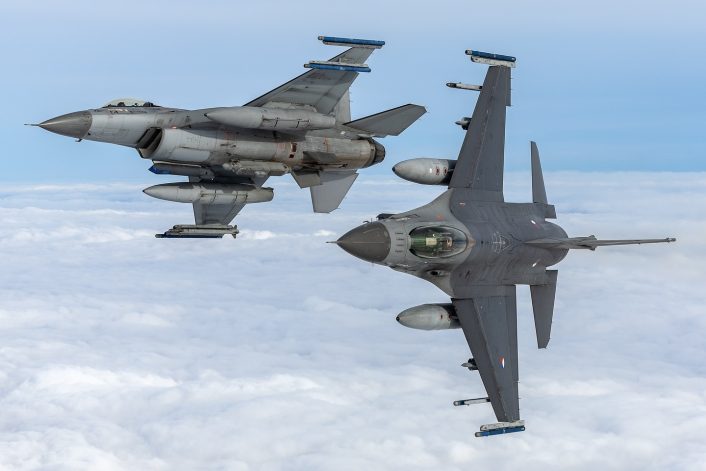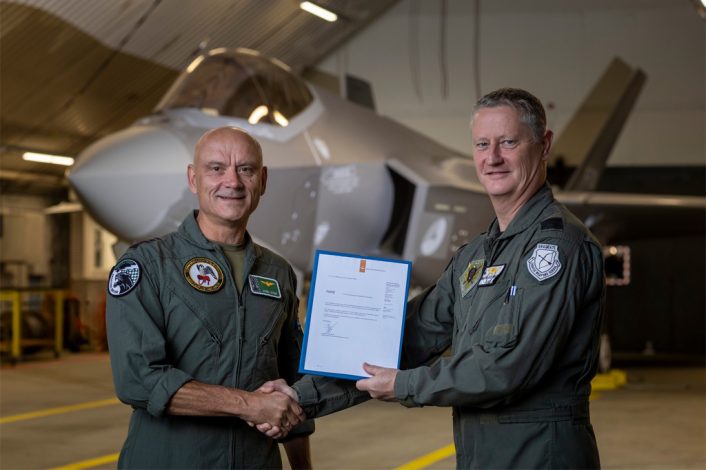With the F-16 retirement, all the operational duties are being transferred to the F-35, making the RNLAF the second air force with a 5th gen-only fighter fleet after it has declared the Full Operational Capability of the type.
On Sep. 27, 2024, the Royal Netherlands Air Force officially retired the F-16 Fighting Falcon. The phase-out of the F-16 from the RNLAF marks the end of a legend. The F-16 Fighting Falcon has been a cornerstone of the RNLAF’s capabilities since the first deliveries in the late 1970s.
To celebrate the service of the Viper, the RNLAF organized a final flight from Volkel to overfly all the significant points for the history of the Viper across the Nation.
Let’s take a look back at some of the key achievements and milestones during the F-16’s service with the Dutch Air Force.
Tijdens de afscheidsvlucht vliegt een formatie F-16’s voornamelijk over de locaties waar de F-16 actief is geweest. De vliegroute en tijden zijn onder voorbehoud van onvoorziene omstandigheden.
Lees meer 👉 https://t.co/Ox83NIapp8 pic.twitter.com/zSYZixC6B8
— Koninklijke Luchtmacht (@Kon_Luchtmacht) September 24, 2024
The Early Days of the Dutch Vipers
The F-16 in the RNLAF marked a significant transition in the nation’s military aviation capabilities. With the need to replace aging aircraft such as the F-104 Starfighter and the NF-5, the RNLAF embarked on a rigorous selection process for a modern, versatile fighter jet. The F-16 Fighting Falcon emerged as the preferred choice over alternatives like the SAAB Viggen and the Dassault Mirage, meeting all the operational requirements.
A pivotal aspect of the F-16’s introduction in the Netherlands was the involvement of the Fokker aircraft company. In fact, as part of the agreement, Fokker was granted the license to build the F-16 in the Netherlands. A new manufacturing facility was established at Schiphol Airport, making Fokker the first production line for the F-16 outside the United States. This facility not only produced aircraft for the RNLAF but also supported the assembly of F-16s for Norway, Denmark, and Egypt, playing a crucial role in the broader distribution of the F-16 across allied nations.
The first F-16 fuselage was sent to Fokker on Sep. 13, 1978 aboard a C-5 Galaxy transport aircraft. From this point, Fokker delivered a total of 306 F-16s, with 213 of those being for the RNLAF. The delivery of the first two aircraft, registered as J-212 (a single-seat F-16A) and J-259 (a two-seat F-16B), took place in June 1979 at Leeuwarden Air Base. This event symbolized a significant advancement in the RNLAF’s operational capabilities, marking the beginning of a new era in Dutch military aviation. The two main operational bases selected to host F-16 squadrons were Leeuwarden and Volkel, the latter later selected as the hosting base for the nuclear capable squadron.
The Pilot Training Process
The pilot training process for the Royal Netherlands Air Force (RNLAF) in the F-16 Fighting Falcon was a crucial component of integrating the new aircraft into their fleet. Dutch pilots were among the first international partners to undergo training in the United States specifically for the F-16, reflecting the close cooperation between NATO allies.
Training took place at Morris Air National Guard Base in Tucson, Arizona, under the 148th Fighter Squadron, which specialized in F-16 operations. This program was not just about teaching pilots to fly; it was about equipping them with the skills to effectively operate and fight in the advanced F-16 platform. The Dutch pilots were trained extensively, accumulating an average of 2,000 flight hours per year. This high level of training ensured that the RNLAF pilots were well-prepared to operate the F-16 in a variety of mission profiles, from air superiority to ground attack.
The training partnership between the RNLAF and the 148th Fighter Squadron at Morris ANG Base lasted for 32 years, making it one of the longest-running international training programs of its kind.
This long-standing collaboration culminated on Jul. 29, 2022, when the RNLAF landed their last F-16 at Morris ANG Base, marking the end of an era. The conclusion of the program symbolized the successful completion of a significant chapter in the RNLAF’s history with the F-16, transitioning towards future advancements in air combat training and capabilities.

The Mid Life Update Process
In the decades following the introduction of the F-16 Fighting Falcon into the Royal Netherlands Air Force, it became evident that the aircraft were subjected to more intense operational loads than initially anticipated when they were first acquired in 1979. The high demands placed on the F-16s led to the development of structural stress and unpredicted cracks in several airframes.
Faced with these challenges, the RNLAF conducted an economic evaluation to determine the best course of action. Rather than purchasing new aircraft, which would have required significant financial investment, the decision was made to upgrade a part of the existing fleet. This approach allowed the RNLAF to extend the operational life of its F-16s while also modernizing their capabilities to meet future combat requirements.
The upgrade package significantly enhanced the aircraft’s avionics and combat systems, incorporating advanced radar, navigation, communication, and electronic warfare capabilities that allowed the F-16s to remain competitive in a rapidly evolving technological landscape. In addition to these critical updates, structural modifications were made to extend the aircraft’s service life, integrating more resilient materials and designs to better withstand future operational stresses.
Notably, the air intake was modified to accommodate new hard points for advanced external sensors, such as the LANTIRN targeting pods, which vastly improved the F-16s’ precision strike capabilities, especially in low-visibility and night operations. These upgrades collectively ensured that the RNLAF’s F-16s could continue to fulfill a wide range of roles in modern combat scenarios, maintaining their relevance and effectiveness well into the future.

Operational Deployments and NATO Contributions
The Dutch F-16s were pivotal in several NATO operations, demonstrating the RNLAF’s dedication to international security and coalition warfare.
In the 1990s, the Balkans were engulfed in a brutal conflict that saw widespread ethnic violence and humanitarian crises. NATO, under the United Nations mandate, intervened to stabilize the region and prevent further atrocities. Dutch F-16s were at the forefront of these efforts, particularly through their involvement in enforcing no-fly zones over Bosnia and Herzegovina as part of Operation Deny Flight. This operation, initiated in 1993, was designed to restrict the airspace above Bosnia to prevent the warring factions from using airpower to conduct attacks against civilian populations or opposing forces. The Dutch F-16s were tasked with patrolling these skies, ensuring that no unauthorized aircraft violated the no-fly zone.
The situation escalated as the conflict continued, leading to NATO’s Operation Deliberate Force in 1995. Dutch F-16s played a critical role in this operation, which involved a series of coordinated airstrikes aimed at weakening the military capabilities of the Bosnian-Serb forces. These airstrikes targeted key military installations, command centers, and infrastructure, significantly reducing the Serbs’ ability to wage war. The Dutch F-16s’ precision and reliability in delivering these strikes were instrumental in compelling the warring parties to come to the negotiating table, ultimately leading to the Dayton Agreement, which brought an end to the conflict.
In 1999, the RNLAF’s F-16s were again called upon during the Kosovo War, another critical NATO intervention aimed at stopping the humanitarian crisis and ethnic cleansing being carried out by Serbian forces. As part of Operation Allied Force, Dutch F-16s were actively involved in a sustained air campaign designed to pressure the Serbian government into ceasing its aggressive actions in Kosovo.
The operation required a high degree of precision and coordination, as the goal was to minimize civilian casualties while effectively degrading the Serbian military’s capacity to continue its operations. Dutch F-16s executed numerous combat sorties, targeting military infrastructure, air defense systems, and key communication nodes across Serbia and Kosovo. These missions were not only complex but also dangerous, as Serbian forces employed a sophisticated network of surface-to-air missiles and anti-aircraft artillery to challenge NATO aircraft. The sustained air campaign ultimately forced the Serbian leadership to withdraw its forces from Kosovo, ending the conflict and paving the way for a NATO-led peacekeeping force to stabilize the region.

The aftermath of the Sep. 11, 2001 attacks saw the Netherlands commit to the global effort against terrorism, with Dutch F-16s being deployed to Afghanistan as part of NATO’s International Security Assistance Force (ISAF). This mission represented a new kind of warfare for the RNLAF, one that involved prolonged deployments in a challenging and hostile environment far from home.
Dutch F-16s were tasked with providing close air support (CAS) to NATO and coalition ground forces engaged in combat against Taliban insurgents. The rugged terrain and insurgent tactics, which often involved ambushes and guerrilla warfare, made air support critical to the success of ground operations. The F-16s’ ability to deliver precision-guided munitions in close proximity to friendly forces was invaluable, ensuring that ground troops could operate with the confidence that air support was just moments away.
In addition to CAS missions, Dutch F-16s conducted a significant number of reconnaissance flights. Equipped with advanced targeting pods and sensors, these aircraft gathered crucial intelligence that helped to inform ground operations, identify insurgent movements, and assess the effectiveness of strikes.
As one of the last operational employments, the F-16 of the RNLAF played an active role in the international coalition against ISIS (Islamic State of Iraq and Syria), a terrorist organization responsible for widespread violence and atrocities in the Middle East. Beginning in 2014, the RNLAF deployed F-16 fighter jets to participate in Operation Inherent Resolve, the coalition’s military campaign aimed at degrading and ultimately defeating ISIS.

The Handoff Phase of the Operational Capabilities
The transition process to the F-35 in the Royal Netherlands Air Force began several years ago, focusing on defining the operational requirements for the new F-35 squadrons. Throughout this period the F-35 gained all the capabilities to cover the F-16s tasks: the handover of the BENELUX Air Defense took place on Mar. 29, 2024 with the last Quick Reaction Alert (QRA) mission conducted by a flight of two F-16s, while on Jun. 1, 2024 the F-35 took over the nuclear role.
The RNLAF declared the Full Operational Capability (FOC) of the F-35 on Sep. 26, 2024 marking an historical moment for the service. With the farewell of the F-16 the Royal Netherlands Air Force becomes the second European Air Force operating exclusively 5th generation fighters.









